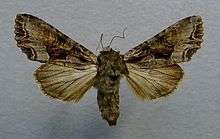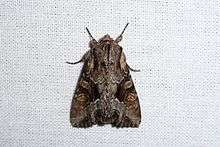Lacanobia w-latinum
Lacanobia w-latinum, the light brocade, is a moth of the family Noctuidae. The species was first described by Johann Siegfried Hufnagel in 1766. It is found in Europe, east to Turkmenistan and Anatolia.
| Lacanobia w-latinum | |
|---|---|
 | |
 | |
| Scientific classification | |
| Kingdom: | |
| Phylum: | |
| Class: | |
| Order: | |
| Family: | |
| Genus: | |
| Species: | L. w-latinum |
| Binomial name | |
| Lacanobia w-latinum (Hufnagel, 1766) | |
| Synonyms | |
| |
Description
The wingspan is 36–41 mm. The species is very similar to Lacanobia contigua. The forewing ground colour is red brown, violet brown, silver grey and dark brown. The reniform and orbicular stains are large and partially reddish tinted. The basal dash is very dark and striking. The midfield and extreme marginal area also stand out also dark, while the inner marginal field is grey brown to silver grey. In the subterminal light wavy line, a large W character is visible, which serves as the basis for the Latin name w-latinum. The hindwings are grey brown and mostly without markings but slightly darkened at the edge, only the dark veins emerge more clearly.
Biology
The moth flies from June to July depending on the location.
The larvae feed on various plants, including Vaccinium species (including Vaccinium myrtillus), Genista, Sarothamnus scoparius, Coronilla coronata, Prunus, Senecio, Calluna, Betula and Quercus.[1]
Main habitat are warm slopes, mixed forests, bushy heaths and park-like landscapes. In the mountains, it rises to a height of about 1600 meters.
References
- Robinson, Gaden S.; Ackery, Phillip R.; Kitching, Ian J.; Beccaloni, George W.; Hernández, Luis M. (2010). "Search the database - introduction and help". HOSTS - A Database of the World's Lepidopteran Hostplants. Natural History Museum, London.
External links
| Wikimedia Commons has media related to Lacanobia w-latinum. |
- Kimber, Ian. "73.263 BF2157 Light Brocade Lacanobia w-latinum (Hufnagel, 1766)". UKMoths. Retrieved 1 July 2019.
- Savela, Markku. "Lacanobia w-latinum (Hufnagel, 1766)". Lepidoptera and Some Other Life Forms. Retrieved 1 July 2019.
- Lepiforum e.V.
- Schmetterlinge-Deutschlands.de
- De Vlinderstichting (in Dutch)